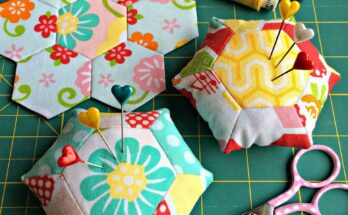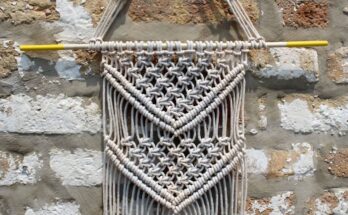
I love the method of sewing across two corners of a pouch or bag to create a flat bottom (this post is going to sound a bit like a cosmetic surgery clinic brochure at times I fear), but sometimes I don’t want the sides of the bag/pouch slope inwards towards the base. I knew that this had to be solvable through the careful application of trigonometry, so…. I decided just to take a guess at how to solve it (‘cos I’m no mathematician). After a few false starts, I managed to draw this pattern which creates a straight-ish sided pouch with a flat bottom. The finished pouch is 9″ wide, 7″ high and around 3″ deep at the base.

I also have an issue with the standard way of doing zip ends. I love to use zip end covers because it gives such a great-looking finish, but I don’t like the fact that you run the risk of getting a hole between the zip end and the side of the pouch. I’ve tweaked this method a little to provide a foolproof finish, by extending the zip end cover past the end of the zip and into the line of the seam. I haven’t seen another method that does it quite like this, but please forgive me if this is a really well known way and I just think I have invented it!
Before you start you need to Download and print the PDF PATTERN. After a considerable quantity of wasted paper testing this, I have found that using Google Chrome or the most up-to-date version of Adobe is the best way to open up the pattern once you have downloaded it. You need to make sure that your paper is oriented to landscapeand ‘fit to page’ or ‘shrink to fit’ is disabled. There is a line marked on the pattern that should measure 6″ – if it doesn’t, then your printer is definitely shrinking to fit, and you need to try again! Once you have printed the pattern, cut it out and match the sections together, aligning the dotted lines and taping into place. You will have 2 pattern pieces – one for the interfacing/fleece, and one for the fabrics.
You will need:
Fabric for outer
Fabric for lining
Iron-on medium weight interfacing
Fusible fleece (low loft or high loft, depending on the weight of the outer fabric you are using – I would use low loft with thicker fabrics).
10″ (minimum) zip
sewing machine and zipper foot
Preparing the fabrics
Cut out two pieces of outer fabric and two pieces of lining fabric, using the larger pattern piece. Cut out 2 pieces of fusible fleece and 2 pieces of iron using the small pattern piece. Cut 2 pieces of fabric 4″ by 1″ – these will form the zip end covers.
Fuse one piece of fleece so it is positioned centrally on one of the outer pieces of fabric, like this:

Repeat with the other piece of fusible fleece and outer fabric. Then interface the 2 lining pieces of fabric with the medium-weight iron-on interfacing, aligning it centrally, in the same way.
Preparing the zip
Take one of the 4″ by 1″ pieces of fabric and fold it in half widthways (middle line in the picture), then mark two lines 3/4″ away from the short edges, as indicated in the photograph.

Fold the two edges inwards on these two lines (1), press, and then and then fold in half again (2) and press.

Repeat to create the other zip end tab. Put to one side whilst you sort out the zip.
Trim the open end of the zip so that it measures 3/4″ past the end of the zip stop (you probably wont have to trim much).

Then measure 9″ from the trimmed end and mark a line and trim the zip to this line.

I put a dot of glue or clear nail varnish on this end of the zip to keep it closed. Another option is to zig-zag stitch over it.
Open up one of the fabric zip end covers and place one end of the zip inside, aligned with folded-in edge (as in the picture below), not with the central fold as you normally would. I use my glue pen (mine is a Sewline) heavily at this point to glue the zip into position. You could use pins, but IMO your life will change for the better when you invest in a glue pen, so do it….

Now fold the zip cover in the middle, on the fold line you made earlier, using more glue or pins to hold it in place – it will look like this, and there with some of the zip end cover extending past the end of the zip:

Repeat with the other zip end cover.
It’s finally time to get the sewing machine out….
Stitch the zip end covers in place close to the edge nearest the zip. I like to use 2 rows of stitching, but you don’t have to!


Place one piece of outer fabric, right side up, and align the zip, face down, with the top edge, like this:


Position one of the lining pieces on top, right sides together with the outer piece, and so the zip is sandwiched between the outer and the lining. I use loads of glue again here (on both sides of the top fabric part of the zip) to hold the zip/fabric sandwich together… You can use pins, but glue is awesome (really).
Fit a zipper foot to your sewing machine and sew along the line indicated in the photo.

You will need to fiddle about with the zip pull to move it out of the way as you sew. My usual technique is to start with the zip pull in the middle of the zip, then sew along until I get as close to it as I can. Then I raise the zipper foot, but keep the needle lowered, and move the zip pull back where I have just sewn, so it is out of the way. Then I put the zipper foot back down again, and away I go to the end.
Repeat all of that with the other two pieces of fabric, on the other side of the zip.
The finishing zip touch is to top stitch along the zip edge on the outside of the pouch. Open out the two side and press the lining and outer fabric thoroughly away from the zip. Then (still with the zipper foot attached), stitch where indicated in the photo, nice and close to the line where the fabric meets the zip.

Don’t forget, if your lining fabric is a completely different colour to the outside, you can, if you want to, use a different colour bobbin thread a this point (that might be obvious to you, but it took me a while to figure that one out).
Sewing it all up
Now for the fun bit… Make sure your zip is at least 3″ UNZIPPED now or you’ll be very sad later when you can’t turn your pouch the right way round… Line up your fabrics so that the outer pieces are right sides together, and the lining pieces are right sides together too. You should end up with something that looks like this:

See how the zip is there in the middle, and the outer and lining fabrics are pulled to either side of it. Pin all round the edges (sorry I took my photo before I finished pinning). There is a lumpy area round the zip that you need to pinch flat in order to sew. Fold the zip cover flat so that it is sandwiched between the 2 pieces of outerfabric, like this:

Once you have pinned everything into place you need to stitch the sides and the bottom of the pouch, leaving the 2 small L-shaped cut outs at the bottom unstitched, and also leaving a 3″ gap on one of the sides so that you can turn your pouch right side out later.
So, stitch where I’ve marked with the dotted lines, with a 3/8″ seam allowance (you will be stitching pretty much along the edge of the interfacing). Remember to do a bit of reverse stitching on each side of the gap you are leaving for turning, or you run the risk of your stitching coming undone when you turn the pouch through.

The final stage before you can turn the pouch right side out, is to stitch the bottom corners of the pouch. Working on one corner, pull the 2 inner angles of the L-shape apart, and open up the L-shaped section. Align the bottom seam and the side seam of the pouch and line up the two edges of the unsewn corners at right angles to the seams, like this:

You should be able to see how you are creating the nice boxy base to your pouch. If it doesn’t look right, it probably isn’t – have another go before you sew! Stitch across the corner, reverse stitching at each end because this bit of stitching needs to be very firm. Repeat this process with the other 3 corners.

Now it’s time to turn the pouch right side out to check all is OK – I always do this before I trim any seams! If you are happy with how it looks (use a crochet hook or knitting needle to push out the zip covers to check they look good), then turn inside out again and trim the seams to 1/4″. Then turn it back through, sew up the turning hole with ladder stitch and then give the whole thing a thorough pressing. And you are all finished!






